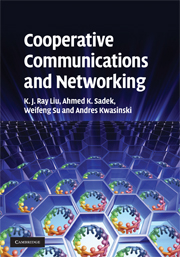Book contents
- Frontmatter
- Contents
- Preface
- Part I Background and MIMO systems
- Part II Cooperative communications
- 4 Relay channels and protocols
- 5 Cooperative communications with single relay
- 6 Multi-node cooperative communications
- 7 Distributed space–time and space–frequency coding
- 8 Relay selection: when to cooperate and with whom
- 9 Differential modulation for cooperative communications
- 10 Energy efficiency in cooperative sensor networks
- Part III Cooperative networking
- References
- Index
7 - Distributed space–time and space–frequency coding
from Part II - Cooperative communications
Published online by Cambridge University Press: 06 July 2010
- Frontmatter
- Contents
- Preface
- Part I Background and MIMO systems
- Part II Cooperative communications
- 4 Relay channels and protocols
- 5 Cooperative communications with single relay
- 6 Multi-node cooperative communications
- 7 Distributed space–time and space–frequency coding
- 8 Relay selection: when to cooperate and with whom
- 9 Differential modulation for cooperative communications
- 10 Energy efficiency in cooperative sensor networks
- Part III Cooperative networking
- References
- Index
Summary
The main drawback of the multi-node decode-and-forward (DF) protocol and the multinode amplify-and-forward (AF) protocol, presented in Chapter 5, is the loss in the data rate as the number of relay nodes increases. The use of orthogonal sub channels for the relay node transmissions, either through TDMA or FDMA, results in a high loss of the system spectral efficiency. This leads to the use of what is known as distributed space–time coding (DSTC) and distributed space–frequency coding (DSFC), where relay nodes are allowed to simultaneously transmit over the same channel by emulating a space–time or a space–frequency code. The term distributed comes from the fact that the virtual multi-antenna transmitter is distributed between randomly located relay nodes. Employing DSTCs or DSFCs reduces the data rate loss due to relay nodes transmissions without sacrificing the system diversity order, as will be seen in this chapter.
Distributed space–time coding (DSTC)
In this section, the design of distributed space–time codes for wireless relay networks is considered. The two-hop relay network model depicted in Figure 7.1, where the system lacks a direct link from the source to destination node, is considered. Distributed space–time (space–frequency) coding can be achieved through node cooperation to emulate multiple antennas transmitter. First, the decode-and-forward protocol, in which each relay node decodes the symbols received from the source node before retransmission, is considered.
Information
- Type
- Chapter
- Information
- Cooperative Communications and Networking , pp. 238 - 277Publisher: Cambridge University PressPrint publication year: 2008
